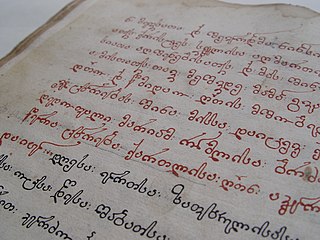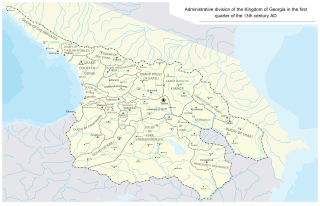The Abazasdze (Georgian :აბაზასძე) were a noble family in Georgia with a surge in prominence in the 11th century.

Georgian is a Kartvelian language spoken by Georgians. It is the official language of Georgia. Georgian is written in its own writing system, the Georgian script. Georgian is the literary language for all regional subgroups of Georgians, including those who speak other Kartvelian languages: Svans, Mingrelians and the Laz.

The Kingdom of Georgia, also known as the Georgian Empire, was a medieval Eurasian monarchy which emerged circa 1008 AD. It reached its Golden Age of political and economic strength during the reign of King David IV and Queen Tamar the Great from 11th to 13th centuries. Georgia became one of the pre-eminent nations of the Christian East, her pan-Caucasian empire stretching, at its largest extent, from Eastern Europe and the North Caucasus to the northern portion of Iran and Anatolia, while also maintaining religious possessions abroad, such as the Monastery of the Cross in Jerusalem and the Monastery of Iviron in Greece. It was the principal historical precursor of present-day Georgia.
The Abazasdze are hypothesized by the Georgian historian Nodar Shoshiashvili to have descended from the house of Tbeli of Kartli. Tbeli Abazay, mentioned in an 11th-century Georgian inscription from the Bortsvisjvari church at Tbeti, may have been the family's eponymous founder, while Ivane Abazasdze, eristavi ("duke") of Kartli, could have been his grandson. [1] Ivane Abazasdze wielded influence in the 1030s, during the early reign of Bagrat IV of Georgia. [2] The contemporaneous Georgian hagiography Vita of George the Athonite by Giorgi Mtsire described Ivane Abazasdze and his four brothers as "heroic and strong in their wealth and boastful of their arms and proud of the multitude of their army." [1] Their failed plot to assassinate Bagrat IV resulted in the family's loss of much of their influence and prestige. They are only rarely mentioned in subsequent historical records, but the Abazasdze appear to have survived in Upper Kartli as royal vassals, aznauri , from the 15th century to the 18th. [1]

Kartli is a historical region in central-to-eastern Georgia traversed by the river Mtkvari (Kura), on which Georgia's capital, Tbilisi, is situated. Known to the Classical authors as Iberia, Kartli played a crucial role in the ethnic and political consolidation of the Georgians in the Middle Ages. Kartli had no strictly defined boundaries and they significantly fluctuated in the course of history. After the partition of the kingdom of Georgia in the 15th century, Kartli became a separate kingdom with its capital at Tbilisi. The historical lands of Kartli are currently divided among several administrative regions of Georgia.

Tbeti is a settlement in the Tskhinvali district of South Ossetia, Georgia. It is located 2 kilometers west of Tskhinvali.
Ivane Abazasdze was an 11th-century Georgian nobleman of the Abazasdze family, who functioned as an eristavi ("duke") of Kartli under King Bagrat IV of Georgia.
By the closing years of the 14th century, a branch of the family was established in Georgia's eastern region of Kakheti and, in the person of Khimshia Abazasdze-Marileli ("of Marili"), who had fought Timur's invading army in 1399, was enfeoffed by the Georgian crown of the former estates of the Abuletisdze in Eliseni in 1405. [3] [4] According to the historian Cyril Toumanoff, the latter-day Kakhetian noble family of Khimshiashvili descended from these "Abazads of Marili". [5]

Kakheti is a region (mkhare) formed in the 1990s in eastern Georgia from the historical province of Kakheti and the small, mountainous province of Tusheti. Telavi is its capital. The region comprises eight administrative districts: Telavi, Gurjaani, Qvareli, Sagarejo, Dedoplistsqaro, Signagi, Lagodekhi and Akhmeta. Kakheti is bordered by the Russian Federation to the Northeast, Azerbaijan to the Southeast, and Mtskheta-Mtianeti and Kvemo Kartli to the west. Kakheti has a strong linguistic and cultural identity, since its ethnographic subgroup of Kakhetians speak Kakhetian dialect.

Timur, historically known as Amir Timur and Tamerlane, was a Turco-Mongol conqueror. As the founder of the Timurid Empire in Persia and Central Asia, he became the first ruler in the Timurid dynasty. According to John Joseph Saunders, Timur was "the product of an islamized and iranized society", and not steppe nomadic.

Georgia, a Christian kingdom in the Caucasus, was subjected, between 1386 and 1403, to several disastrous invasions by the armies of Turco-Mongol conqueror Timur, whose vast empire stretched, at its greatest extent, from Central Asia into Anatolia. These conflicts were intimately linked with the wars between Timur (Tamerlane) and Tokhtamysh, the last khan of the Golden Horde and Timur’s major rival for control over the Islamic world. Timur officially proclaimed his invasions to be jihad against the region's non-Muslims. Although he was able to invade parts of Georgia, he was never able to make the country Muslim and even recognized Georgia to be a Christian state.





